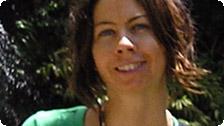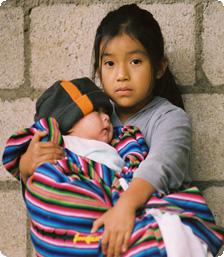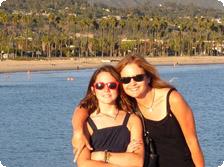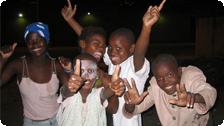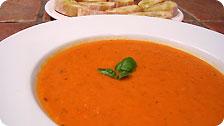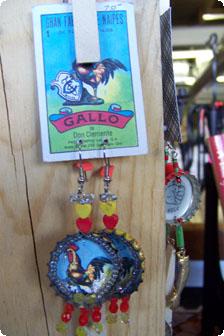Inspiration: Australia By Mistake
by Katherine Losse
I ended up in Australia by mistake. I was supposed to go to London for the semester, but due to some anonymous, last-minute bureaucratic incompetence, I ended up bound for Sydney instead. I told myself I was game for anything…right?
Arriving in Sydney
I boarded the plane to Sydney with a backpack full of clothes, sneakers, sunscreen, a few books, my laptop, and my ipod. I was on my way to the other side of the earth, where I knew no one.
“Help! I am in the wrong hemisphere,” I thought to myself as I exited the glass doors of the airport and walked out into the Sydney sun. It was too sunny to be London, too British to be Los Angeles, too hot to be February, and too far from a familiar latitude and/or longitude to feel anything like home. I began to panic. It was too late for second thoughts, though—my five-month Australian adventure had begun.
Due to the same last-minute bureaucratic incompetence that had sent me to Australia rather than Great Britain, there were a few other hitches in my itinerary. One was that I had no place to live. Unlike the other American students who were hooked up with cushy, pre-furnished flats and catered to by assorted Directors whose sole purpose was to make their international experience a wrinkle-free (and adventure-free) one, I was completely on my own. As far as the University of Sydney was concerned, I was just a student like anyone else. There was only one small flaw in that logic: I had just set foot in Australia yesterday.
Having been pointed to temporary lodging at a ponderous, olde English-style dorm by a kind-hearted soul at the Sydney University Housing Office, I spent my first night in Sydney in a dark-wood-paneled, faux-Oxfordian dorm room with diamond-paned windows and antique (some would say antiquated) furniture. It could have been charming, but my mindset was wholly disoriented. First of all, despite the fact that it was February, summertime was in full swing. Thus, my ye-olde-Oxford dorm room was wiltingly humid, and the diamond-paned windows did nothing to induce a breeze. Outside on the manse-like lawn, stately oaks and elms mingled with tropical palms to create an oddly admixtured landscape. When I saw the cockroach trap under my desk (subtropical climes accept cockroaches as a fact of existence, I later learned), I jumped on the lumpy dorm bed, screwed my eyes shut, and willed myself to fall asleep. I am in a bad dream, I thought to myself. Please wake up.
I woke up the next morning with a splitting headache, as if all the blood had rushed to my head. “Maybe that is because in Australia I am really standing upside down,” I thought, with flawed geospheric logic—but logic which sounded perfectly plausible to me in my state of jet-lagged, continent-shocked confusion. After a breakfast of Weetabix and Lucozade at the dorm dining hall, I screwed up my courage for my first order of business: finding a permanent place to live.
Following my map, I set off from the Uni towards Newtown’s main drag. The streets around the University of Sydney were like no college town I had ever been in. I felt as if I had landed in a subcontinental British colony to film a remake of A Passage to India. The streets were lined with brightly-colored, two-story, vine-trellised buildings called terrace houses. Each one had a wrought-iron balcony on the second floor, and a wrought iron fence and gate separating the house from the rough-textured asphalt sidewalk in front. There was something slow and otherwordly about these streets, a feeling of subtle exoticness that I would sense for as long as I lived there. Stepping off the curb to cross the street, I made sure to look to my right (as my father warned me, before I left America, “it’s the car coming on the right that will kill you”) before striding across the fat white British-prototype stripes of the crosswalk. I swung my arms wide, pretending I was on the cover of the Beatles’ Abbey Road, to make myself laugh.
King Street, Newtown’s main commercial thoroughfare, was the most bizarre conglomeration of cultural influences I had ever seen. Setting off down the narrow, curving street, I was overwhelmed by the scents of falafels, curries, frying meats, and stewing vegetables assaulting my nose as my eyes squinted under the glaring Australian summer sun. Under awnings, messy-aproned storeowners hawked everything from used books to Middle Eastern cuisine to gourmet coffee to adult videos to vintage clothing to housewares to Vietnamese fast food to fine wines. Garish, neon-lit bars served pints of Toohey’s and Victoria Bitter beer (not Fosters—no one in Australia actually drinks that) to brawny “mates” all day and into the night.
After pacing the sweltering streets for hours, looking at everything from a dingy room above a fly-by-night women’s clothing store to one-half of a terrace house in a cracked and crumbling portion of Sydney’s ghetto (finding out in the course of the day that one of the quainter aspects of terrace house architecture is that the bathroom is detached from the house, in a back courtyard), I finally found a flyer that said, simply, “Flat-mate wanted, 6 Georgina Street, $75 a week.” I “rang on” 547932, and was fortunate enough to get an answer.
“’Ello,” the person said, with a thick Australian accent that sounded almost incomprehensible to my virgin ears.
“Yes, I’m calling about the room advertised,” I said.
“Oh, yeah, we’ve been doing interviews for the room all day, actually. Would you like to stop by right now?” I said yes, asking for directions and finding out that Georgina Street was only a few blocks from where I stood at the bright-yellow Austel pay phone.
“That’ll be right, then,” the person said. I hung up and walked up King Street, sidestepping racks of clothing and displays of Aboriginal arm jewelry. Turning right onto Georgina, I found myself on a cool, sloping street shaded by enormous eucalyptus trees, the trunks of which were bound by thick, woolly vines. The effect was very jungle-y and tropical, and was heightened by the very traditional colonial architecture of the terrace houses lining the street. I knocked at the gate of 6 Georgina, and was welcomed by a young woman with long red hair wearing a flowing batik skirt.
“My name is Sarah, how do y’do,” she said in a musical Australian accent that I later would learn to distinguish from the more raw, flat-noted accents of the Australian working class (otherwise known as “yobbos,” a word akin to “redneck,” that educated Australians use to refer to more provincial, lower-middle-class Aussies).
Sarah ushered me into the dim foyer of the house. The ceiling was high and ornately carved. Sarah led me to a wood-floored lounge room outfitted with all the trappings of young bohemian life. Indian prints adorned the furniture, incense burned, and books on zen meditation and rune reading lay open on the coffee table. The residents of the house sat, casually smoking hand-rolled cigarettes, while Sarah introduced me. Cartia was a statuesque young woman wearing a flowing nightgown-like dress and a bindi (the dot of decoration, often made of glitter or ink, that Indian women wear) on her forehead. The rest were similarly turned out, like Sarah and Cartia, in the style of the young, white, upper-middle-class bohemians that they were. I felt like I had traveled back in time to when I was little, when my parents lived in a house full of Indian-print pillows and had all their bohemian friends over to do yoga and meditate in the living room. In other words, I felt—although somewhat anachronistically—right at home.
Though I was dressed in blue corduroys and green Vans—more 2003 alterna-kid than ‘60s bohemian—the residents of 6 Georgina must have felt the same conviviality with me that I felt with them. Out of a pool of twenty candidates, they picked me to be their new flatmate. Now, at least, I had a home. Australia, though still strange, was starting to seem a bit more comfortable.
As I unpacked my meager belongings, the smell of curried spices wafted into my room from the kitchen. On the first night in my new house, and most every night for the rest of my stay, the flatmates of 6 Georgina collaborated on a voluptuous vegetarian meal involving all manner of vegetables, the health-grain-of-the-week (quinoa! jasmine rice!), and complicated alchemies of spices. The maintenance of the kitchen was important to the Georgina household: every Sunday, we made a house voyage down to Paddy’s market, where we picked out boxfuls of fruits, vegetables, tofu, and nuts from an acre of vendors hustling their produce. Australia’s proximity to Asia and the South Pacific meant that there were fruits for sale that I had never seen before: Fuji fruit, custard apples, rambutans….My favorite was a kind of fruit that, when the skin was burst, revealed a well of sweet, chocolate-y flavored “pudding.”
Once the semester started, I got into a routine that masked the loneliness inherent in a life so remote from home. Immersing myself in art and literature classes, I concentrated on observing as much about this new city and new continent as possible. Australians as a whole were a marvelously friendly people, treating me always with utmost warmth although, and in spite of, the fact that I was foreign—and American, a nationality that, as anyone who travels internationally knows, is not always highly esteemed (and perhaps understandably so).
Exploring the Country
After two months in Sydney—living at 6 Georgina, getting along well with my oh-so-organic and free-spirited housemates, and experiencing enough of Sydney to get almost a little bored (after the Sydney Gay and Lesbian Festival in late February, in which the entire city gets decked out in feathers and sequins and turns out to see the city’s finest drag queens strut their stuff on floats up and down Sydney’s posh Oxford Street, it was all downhill as far as exciting nightlife was concerned), I was ready for a new challenge. I took off for a three-week trip across and around Australia.
Alighting from the plane in Cairns, on the continent’s north-east coast, I was in another latitudinal world entirely. Whereas Sydney was half A Passage to India, half Los Angeles, Cairns was strictly Banana Republic. As in, people actually wore khaki shorts (actually, khaki seemed to be the only color that clothes came in) and tight-woven explorer hats while they bounced jauntily in Jeeps across palm-frond-littered roads. I thought that only happened in some Hollywood movie exec’s colonial deserted-island dreams. There I was, however, walking among the gently swaying palms, light breeze, and whitewashed bungalows of Cairns, Australia—looking more than a little out of place in my decidedly non-khaki black pants and Vans.
I booked myself into a youth hostel, and spent my first day in Cairns wandering around the town, wearing a straw hat and giggling at the extreme tropical-outpost feel of the place. At the outdoor market, where produce was heaped onto tables under makeshift roofs of palm thatch, I bought a bagful of rambutans and fuji fruit and struck up conversations with Crocodile-Dundee types wearing snaggle-tooth necklaces and who told me about Aboriginal legends. That night, a fellow youth-hostel mate and I hit the Cairns bar scene (all three of them) and drank Victoria Bitters with leathery-faced old men who told us of their illustrious careers farming sugar cane and operating radio outposts in the jungle around Cairns.
After Cairns, I headed to Alice Springs, the town in the heart of the outback that classifies as the most remote place on earth, for reals. To get there, my Qantas puddlejumper plane chugged over 1,500 miles of the reddest earth I had ever seen. There were no clouds over all of the Outback that day, so I could see every inch of red and rock. If I didn’t know better, I would think that T.S. Eliot had been to the Outback before he wrote “The Waste Land.” (“Where the sun beats, and the dead tree gives no shelter, and the dry stone no sound of water… come in under the shadow of this red rock and I will show you something different from your shadow at morning striding behind you…I will show you fear in a handful of dust.”) I watched the shadow of the plane as it flitted below and behind us on the cracked, endless earth all the way to Alice Springs.
Warming up to all this end-of-the-earth apocalypse that seemed to be Alice Springs, imagine my surprise when I landed and….I felt like I was right back in my hometown of Phoenix, Arizona! The airport was decorated with the art of Australia’s aboriginal peoples, which to the unschooled eye looked remarkably similar to Arizona’s Native American art. It was the landscape, however, that brought on a rush of the most overwhelming homesickness that I had felt since I left Arizona. The red rock and blue sky of the Australian outback, and the waxy green brush that sprang in tangles from its parched dirt, was as close to Sonoran as you could get—being 24,000 miles away and in another hemisphere, to boot. The town of Alice Springs itself reminded me of the rural Arizona towns, like Page, where my high school tennis team used to travel for away games. The buildings were low and ramshackly, the streets wide and silent under the too-big, too-heavy sky.
I strolled about the town, poking into small shops that sold everything from Aboriginal didjeridoos to semiprecious stones to bush gear. The next day I bought a loaf of “bush bread” and some trail mix and hiked out into the desert. The eucalyptus, the heat, and the swirling red dust that threatened to choke me made me almost swear that I was merely hiking in the foothills around Sedona…except that I wasn’t. That night I climbed to a lookout and watched the sun go down over the desert. It was the most sublime sunset I have ever seen. Tears came to my eyes—whether out of homesickness or aesthetic overwhelmedness or both—as I watched the fiery reds and golds of the setting sun get eaten by the all-consuming purple of the isolate outback night.
After Alice Springs, I returned to Sydney with a new appreciation for this immense land called Australia. For the rest of the semester, I kept busy with school, peppering it with weekend trips to places like Katoomba and Melbourne. At night, holed up in my sparsely furnished room on Georgina Street, I would drink tea to keep warm (by May, winter was setting in and the old terrace houses hadn’t heard of central heating) while listening to voices in one of a thousand languages that came in on my transistor radio.
When June came, and I could finally go home (after a brief stopover in Fiji), I was relieved to be able to shed much of the rigid, travel-honed, über-alert independence that I had built up in months of traveling alone on a looming and unfamiliar continent. But, no matter how easy and comfortable a routine I fell into when I returned to America, I vowed never to shed all of that independence. Landing back on the tarmac at Sky Harbor, where the red rocks really did spell home, I was no longer scared anymore. I was stronger, confident, steely, flexible. I had been to Australia, and back.
* * * *
Katherine Losse is a graduate student in literature at Johns Hopkins University, who has recently traveled to Brazil and Cuba.
Discover more from Tango Diva
Subscribe to get the latest posts sent to your email.
